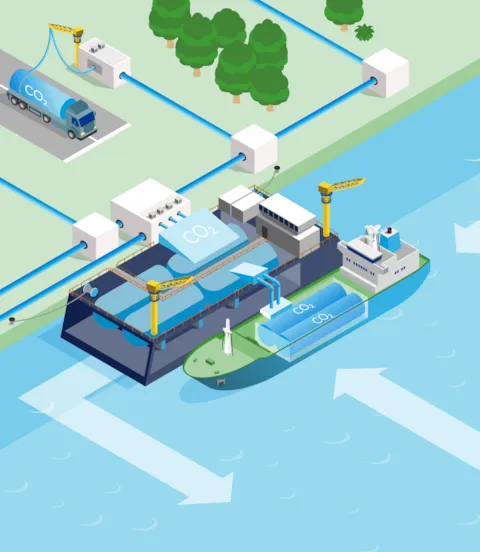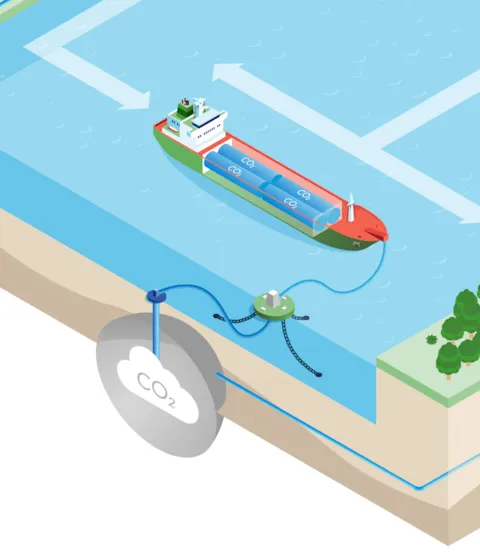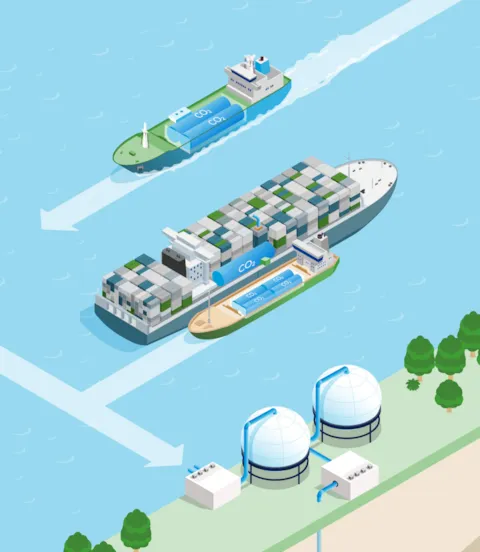What are the key considerations for onboard carbon capture?
Onboard carbon capture (OCC) can be a technically feasible option for reducing emissions and could be commercially attractive if the right regulatory and market drivers are in place. A new DNV white paper provides a comprehensive overview of all key considerations around OCC.
The findings reported in the white paper The potential of onboard carbon capture in shipping (‘the paper’) come as several pilot projects are being conducted or planned on ships worldwide to plug gaps in knowledge of onboard carbon capture technologies and their use.
Guidance to evaluate the feasibility of carbon capture for your fleet
The paper notes that while onboard carbon capture can be safely implemented on ships, further development and optimization are needed for maritime use and integration. It concludes that for OCC to appeal to shipowners, regulations crediting carbon capture must be adopted, and greater development of carbon capture, utilization and storage (CCUS) is needed to complete the value chain.
“The paper offers guidance to shipowners, technology providers and other stakeholders on central matters related to onboard carbon capture,” says Dorthe Slotvik, Consultant, Environment Advisory at DNV and the lead author of the paper. “Its techno-economic insight helps inform a decision-making process for investing in decarbonization technology options to future-proof fleets as emissions regulation continues to evolve and tighten.”
Which onboard carbon capture technologies were assessed?
Onboard carbon capture is based on technology which captures carbon on board the ship before CO2 is emitted to air.
Among the known technologies for carbon capture, the category of post-combustion methods, which separate carbon from the exhaust after burning fuel, are the most relevant for conventional marine energy systems. These methods include chemical absorption, membrane separation, cryogenic separation and mineralization. For fuel-cell systems with liquefied natural gas as fuel, pre-combustion or oxy-fuel combustion are possible but currently underdeveloped methods in shipping because of the low adoption of such fuel cells.
Other candidate technologies are related to the conversion of CO2 to other molecules, but these are at a less mature stage.

Balancing technology, economics and emissions is key
Onboard carbon capture requires energy, usually heat and electricity, to operate capture and treatment systems, which may lead to additional fuel consumption, a ‘fuel penalty’. The trade-off between the achievable emissions reduction and the fuel penalty is a key challenge in onboard carbon capture, affecting both the environmental and economic viability of the technology.
The fuel penalty depends on the capture technology and capacity, and its utilization during normal vessel operation. Systems that achieve a high emissions reduction can deliver low emissions but may have excessive energy demands, making them less feasible from operational and cost perspectives.
The white paper elaborates on these complex relationships.

Onboard carbon capture is technically feasible
Studies have shown that onboard carbon capture can be applied safely on ships but still needs to be further developed and optimized for maritime use and integration.
DNV’s paper discusses key factors affecting the feasibility of onboard carbon capture for specific vessels, such as the operational profile and trading pattern, machinery capacity for power and heat generation, and space availability on board.
The paper presents key considerations when assessing whether to install onboard carbon capture, and what technology to use.

Assessing the economics of onboard carbon capture
While technically feasible, the appeal of onboard carbon capture to shipowners also hinges on its commercial performance relative to other decarbonization alternatives.
Key factors in the economics analysis include cost elements of the system, as well as the regulatory and competitive landscapes.

Regulation and carbon prices central to uptake of OCC
Assuming that decarbonization of shipping is enforced, uptake of onboard carbon capture will depend on regulations crediting captured CO2, and on commercial performance relative to other decarbonization options.
The EU Emissions Trading System is currently the only regulatory framework incentivizing onboard carbon capture, though not including a verifiable method to measure and monitor the derogated emissions. The International Maritime Organization (IMO) is planning to include onboard carbon capture in its Lifecycle Assessment (LCA) Guidelines. In March 2024, MEPC 81 established a group to develop a regulatory framework for using onboard carbon capture systems.
“A continued drive to rapidly develop regulations that credit onboard carbon capture will reduce uncertainty for the industry and support the development of relevant technologies,” says Chara Georgopoulou, Head of Maritime R&D and Advisory Greece, OCC Manager and co-author of the paper.

The importance of carbon capture, utilization and storage value chains
Wider uptake of onboard carbon capture also depends on its integration in broader carbon capture, utilization and storage (CCUS) value chains.
Scaling up CCUS infrastructure across geographies and nations will underpin the uptake of onboard carbon capture technology, the paper concludes.
“This infrastructure is not yet established. Maritime should collaborate with CCUS development projects near major shipping hubs to discuss how shipping can connect to CCUS value chains for depositing CO2 in the system,” says Dorthe Slotvik.
Chara Georgopoulou adds: “In summary, our economic analysis suggests that if the decarbonization of shipping is enforced through regulation and market-based mechanisms such as carbon pricing, onboard carbon capture may be commercially attractive if high capture rates, low fuel penalties and low CO2 deposit costs can be achieved.”

Practicalities of integrating onboard carbon capture
The takeaway from the paper is that shipowners investigating decarbonization alternatives could evaluate the techno-economic conditions under which OCC would be a commercially viable option, alone or in conjunction with other strategies.
“In general, an ‘OCC-ready’ thinking approach could be relevant at the newbuilding stage to reduce the cost for future potential OCC retrofits. The design requires reassessment in terms of stability, strength, visibility and operational safety, to ensure, among other things, the presence of safeguards, safe passages and maintenance routes,” says Chara Georgopoulou. “DNV has been working on onboard carbon capture technologies since 2009 and can support stakeholders wanting to investigate its feasibility and its connection to the value chain.
“The paper also provides an overview of design challenges for some selected vessel types, but in general onboard carbon capture can be a feasible solution for many segments, depending on the vessel’s operational profile and design characteristics,” Georgopoulou concludes.

Chara Georgopoulou
Head of Maritime R & D and Advisory Greece, OCC Manager
Dorthe Alida Arntzen Slotvik
Consultant, Environment Advisory at DNV Maritime
- With Shutterstock imagery
- DNV
